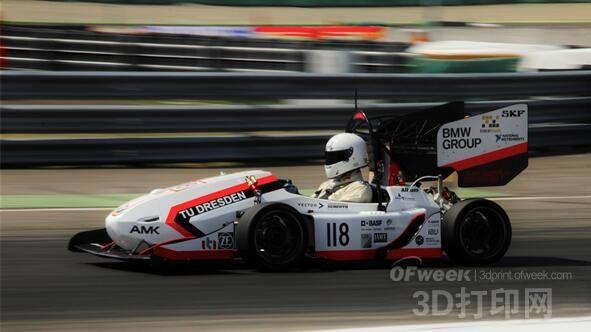Project Introduction
MICHAELSü? is a researcher at the Technical University of Dresden, Germany (TechnischeUniversit?t Dresden), and his current Ph.D. research focuses on additive manufacturing /electron beam melting technology. In addition, Michael is also working closely with the Fraunhofer Additive Manufacturing Technology and Advanced Materials Institute (IFAM) in Germany. FraunhoferIFAM is one of Europe's leading research institutes in the fields of bonding technology, materials science and manufacturing technology.
Michael tried to find a case to apply to his research report. At this point he recalled the experience of being involved in the student Formula Racing team. Michael said, “I worked in a Formula Racing team and wanted to help the University of Dresden's school team. I asked the ELBFLORACE Formula Racing team to recommend a volunteer to work on it. Therefore, Michael met LucasHofman, a student at Dresden University of Technology.

challenge
Together with Lucas, Michael began looking for the most redesigned parts in the car and produced them in additive manufacturing/electron beam melting. In the end, the part they selected was the steering column base of the Formula One. Lucas pointed out that “the current steering column base has four different areas with different angles to each other. Therefore, it is very difficult to manufacture with a 5-axis milling machine. The current solution for this part is made up of four different milling. The aluminum parts are composed and bolted together. We also found some other parts that need to be redesigned and can be produced by additive manufacturing techniques, such as columns. But we finally chose the steering column base because we feel that through this Partial improvements can make the most significant performance improvements and weight improvements."
“I like the easy-to-use features of PolyNURBS, which allows us to quickly get optimized results and rebuild parts, and accelerate into the manufacturing phase. In the past, this has always been the most difficult part of using optimization techniques. We don’t There is a need to use multiple reverse engineering tools, which can now be done in one tool, Inspire."
——MICHAELSü?, Researcher, Dresden University of Technology, Germany
solution
Michael and Lucas are solidThinkingInspires that are learned in different ways. Michael first came into contact with Inspire at a seminar at the Euromold International Mould Show. Lucas is the tool that was learned in the Formula Student Workshop. They were immediately attracted to the convenience brought by the tools. Michael pointed out, "I like the useful features of PolyNURBS too much. It allows us to quickly get optimized results and rebuild parts, and accelerate into the manufacturing phase. In the past, this has always been the most difficult part of using optimization techniques. We no longer need to use multiple reverse engineering tools, which can now be done in one tool, Inspire.†Michael and Lucas also noticed that Inspire also integrates analysis tools that allow them to simulate parts in the real world. The conditions of the work.
Because of the use of electron beam melting to produce parts, Michael and Lucas have a lot of freedom in designing parts. Michael pointed out: "Electron beam melting has great advantages over other manufacturing methods. Our design can be quite free because there are very few design constraints." After mastering Inspire, Michael and Lucas are very determined that this is their implementation. The ideal tool for optimizing and refining the final manufacturing model. Lucas pointed out: "Inspire topology optimization technology allows us to determine the ideal material layout of the part. The PolyNURBS tool allows us to switch the model from the optimization stage to the manufacturing stage very quickly. The entire part refining process takes only 5-7 hours, which is really too Soon!"
Once the new parts have been redesigned based on Inspire optimization results, the next step is to make them. This phase of the team was completed in cooperation with FranhauferIFAM. This process uses an ArcamA2X electron beam melting device. Michael explained, “The parts are manufactured in about 29 hours and are made of titanium. The electron beam melting technology is very important for this process because there is no need to add a lot of support structures like other additive manufacturing methods. After that, the part weighs 330g, which is 35% lighter than the original part's 500g. Without the Inspire, such a large weight savings is impossible. Inspire's topology optimization and its PolyNURBS tool are very impressive, it makes us Being able to transition from optimization results to final manufacturing parts at an extremely fast rate, we will definitely use Inspire more in the future."
The CAS Registry number of Poly(L-lactic acid) PLLA is 33135-50-1. It is white powder. We can provide Intrinsic viscosity from 0.30-2.25 dl/g, Mw from 6000-30000.
For each batch a certificate of analysis is provided, showing the analytical data determined in our quality control laboratory. Additional analytical data can be made upon request.
When stored in the original packaging at low temperatures (2-8°C), PLLA keeps its initial properties for at least two years.
Rimless Industry Co., Ltd. (RIMLESS) is devoted to the global brand operating and integrating, sale and after-sale services of biomedical materials, high-end medical devices, regenerative aesthetic products,cosmetics and beauty tools.
RIMLESS is the exclusive distributor, exporter and global brand licensor of REBORN. We take REBORN and RIMLESS as the core brands, biomedical materials and their applications in the medical field as the main business, and the high-end medical devices as the research and development direction.
We have exported over 50 countries and areas in the world and won a very good reputation and long-term partnership with our customers.
Poly L-Lactic Acid Plla,Biodegradable Polylactic Acid,Polylactic Acid Material,Biodegradable Polylactic Acid Plla
Rimless Industry Co.,Ltd. , https://www.rimlessmedbeauty.com